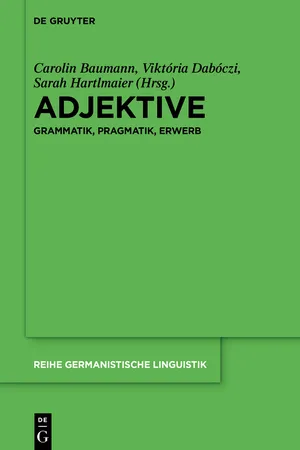1.1Reference, predication and modification
Linguistic operations which create a proposition are called propositional acts in Searle (1969) and may here be called propositional operations on the understanding that an act may be composed of operations, while an operation is by definition elementary. Moreover, in speech act theory, propositional acts are bound up with a speech act, whereas propositional operations, as we shall see shortly, may grammaticalize at lower levels of linguistic structuring, where conscious control is not necessarily involved.
Two propositional operations are firmly established in semantic theory: Reference is “an act of identifying some entity that the speaker intends to talk about” (Searle 1969: 85). Predication (Searle 1969: 102) ascribes a property to a referent. While the idea behind the latter definition is hardly improvable, the choice of the term ‘property’ is unfortunate in two respects: First, in the underlying logical theory, a property is by definition a monovalent predicate. This definition, thus, presupposes a binary division of a proposition into subject and predicate. Such a division is indeed often reflected in linguistic structure, but not always. Predications that predicate a relation between arguments should not be excluded by definition (cf. Lyons 1977: 434–435). Second, in the conception used in what follows, a property is a predicate of a special semantic kind, contrasting, among other things, with the concepts of state and of event. It therefore seems preferable to say that a predication ascribes some semantic content to referents. Both of the operations of reference and predication are necessary for a proposition.1
In (1a), the chalk is used as a referring expression. In #b, an argument is used as a predicate, and so is argued in #c.
| (1) | a. | Would you pass me the chalk? |
| b. | That is an argument. |
| c. | Peter argued. |
For a long time, linguistics has deviated from logic in counting with a third operation of a similar kind, viz. modification.2 Modification enriches a concept. It is neutral to the alternative of whether the modified is a referential or a predicable concept.3 With or without the modification, the former may then function as an anchor in reference, i.e. as the notional core of a referential expression, as in (2a), or be converted into a predicable, as in #b, while the latter may directly function as a predicate, as in #c.
| (2) | a. | Would you pass me the red chalk? |
| b. | That is an invalid argument. |
| c. | Peter argued erroneously. |
As revealed by a comparison of (1) and (2), the referential and predicative operations are constitutive for the propositions in question, while the modifications are optional. They are optional not only in syntactic terms; from a semantic point of view, too, the sentences of (1) are complete and meaningful and may succeed if used in utterances. By contrast, the heads of the referential and predicative expressions of (2) fail on the syntactic condition: If the modified heads are dropped, as in (3), the sentences become ungrammatical.
| (3) | a. | *Would you pass me the red? |
| b. | *That is an invalid. |
| c. | *Peter erroneously. |
Given this, it is hard to judge about semantic acceptability or completeness. Certainly there are languages in which the counterparts to (3) would be grammatical – even if elliptic – and meaningful, e.g. in Latin and Russian. This, however, presupposes one of two things: Either further operations are involved which provide empty heads to the modifiers, as would be the case in the two languages mentioned. Or else the translation equivalents of the modifiers of (2) are not born modifiers, but instead of a nominal or verbal category.
The members of some word classes are “born modifiers”; members of other word classes must be converted before they can serve as modifiers. The modifiers in (2a) and #b are simply preposed to their heads, without any further structural apparatus being required. By contrast, the modifier in (4) is not identical with the referential expression it is based on.
| (4) | This is Sheila’s handkerchief. |
Sheila is a pure noun phrase and semantically a referential expression. Sheila’s is a cased noun phrase which does not refer to Sheila but to the set of things which are hers. This gets clearer in constructions like (5).
| (5) | This handkerchief is Sheila’s. |
(5) obviously does not say that the handkerchief is Sheila but that it is in the set of things that are related to Sheila as a possessor. Applying the genitive to a nominal expression like Sheila thus downgrades it to the syntactic function of a modifier and semantically converts the referring expression into a function. Such a function is, semantically, a subordinate predicate in the same sense as the modifiers in (2).4 The crucial difference is that the function in (4) has been created by an operation, while the modifier in (2a) and #b is the product of no visible operation.
All modifiers share their combinatory potential, which is some kind of self-subordination to a syntagma ...

